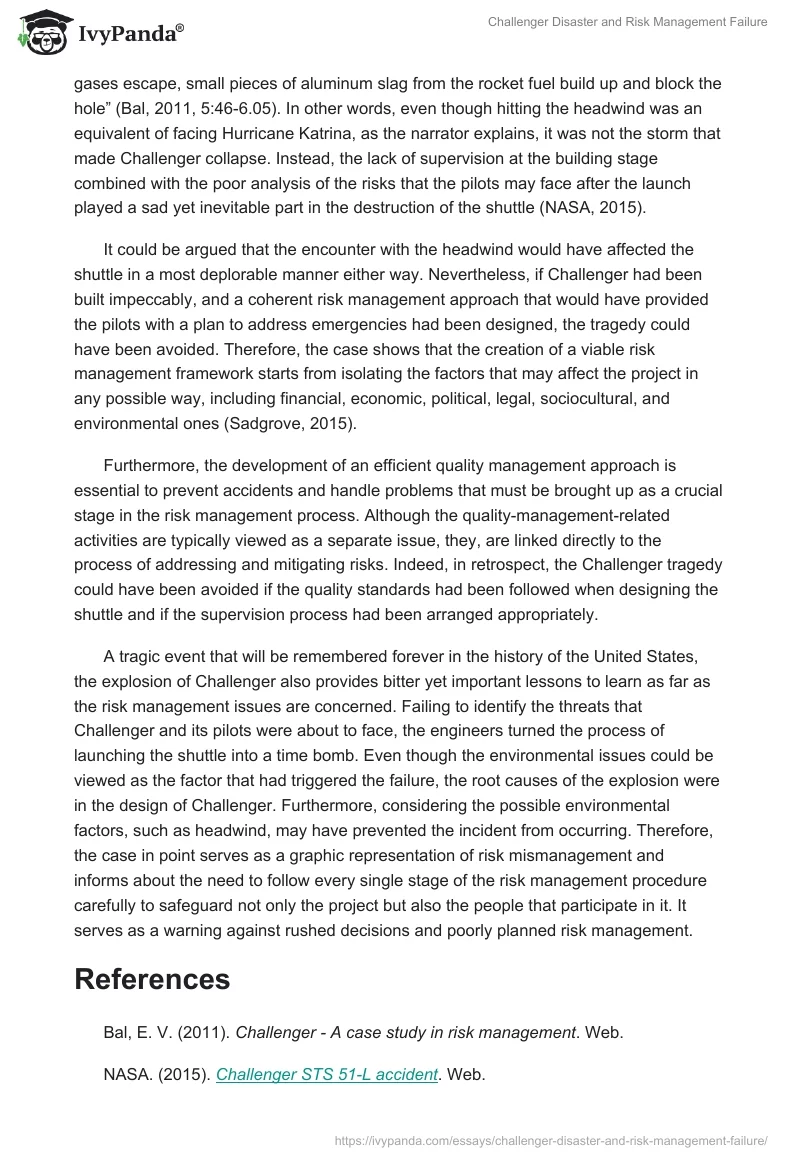Designing an efficient risk management strategy is crucial to the existence of any project or entrepreneurship, as well as the safety of its members. Although foreseeing every possible threat that may jeopardize the security of the project and its members are barely possible, it is still necessary to design the framework that will help address emergencies. Otherwise, the consequences of an unexpected shock may be dire, as the infamous case of Challenger and its unexpected explosion has shown. As the notorious example shows, the stage involving detailed and scrupulous tests of the project design, as well as the assessments of any possible flaws with their further elimination from the product, are to be completed fully so that the crucial threats to the wellbeing of the participants involved could be maintained and that the project losses could be driven to their minimum.
While the importance of the negative outside effects is not to be underrated when designing an appropriate risk management framework, the case study points clearly to the necessity to identify the internal issues before launching the project. According to the details provided in the Challenger case study, the strong headwind was the trigger for the disaster to happen, but it was not the core reason for the problem to occur in the first place. Indeed, as the narrator explains, the problems in the design of the shuttle were the key to understanding why the tragedy took place (Bal, 2011). In other words, the case is a graphic representation of the drastic effects that the inconsistent leadership approach, in general, and the lack of supervision coupled with a poor quality management framework must have affected not only the end product but also the lives of people that were involved in its development.
When defining the stage of risk management at which the loopholes in the project safety emerged, one must admit that there might be variations in determining the determinants affecting the failure of Challenger. However, it would be safe to say that the problems started to show at the third stage of the risk management process (risks evaluation). Going into further detail, one should mention that the people involved in designing the shuttle failed to design the attachment rings so that they could withstand a rapid change in temperature (e.g., a drop thereof as in the case in point): “As superhard gases escape, small pieces of aluminum slag from the rocket fuel build up and block the hole” (Bal, 2011, 5:46-6.05). In other words, even though hitting the headwind was an equivalent of facing Hurricane Katrina, as the narrator explains, it was not the storm that made Challenger collapse. Instead, the lack of supervision at the building stage combined with the poor analysis of the risks that the pilots may face after the launch played a sad yet inevitable part in the destruction of the shuttle (NASA, 2015).
It could be argued that the encounter with the headwind would have affected the shuttle in a most deplorable manner either way. Nevertheless, if Challenger had been built impeccably, and a coherent risk management approach that would have provided the pilots with a plan to address emergencies had been designed, the tragedy could have been avoided. Therefore, the case shows that the creation of a viable risk management framework starts from isolating the factors that may affect the project in any possible way, including financial, economic, political, legal, sociocultural, and environmental ones (Sadgrove, 2015).
Furthermore, the development of an efficient quality management approach is essential to prevent accidents and handle problems that must be brought up as a crucial stage in the risk management process. Although the quality-management-related activities are typically viewed as a separate issue, they, are linked directly to the process of addressing and mitigating risks. Indeed, in retrospect, the Challenger tragedy could have been avoided if the quality standards had been followed when designing the shuttle and if the supervision process had been arranged appropriately.
A tragic event that will be remembered forever in the history of the United States, the explosion of Challenger also provides bitter yet important lessons to learn as far as the risk management issues are concerned. Failing to identify the threats that Challenger and its pilots were about to face, the engineers turned the process of launching the shuttle into a time bomb. Even though the environmental issues could be viewed as the factor that had triggered the failure, the root causes of the explosion were in the design of Challenger. Furthermore, considering the possible environmental factors, such as headwind, may have prevented the incident from occurring. Therefore, the case in point serves as a graphic representation of risk mismanagement and informs about the need to follow every single stage of the risk management procedure carefully to safeguard not only the project but also the people that participate in it. It serves as a warning against rushed decisions and poorly planned risk management.
References
Bal, E. V. (2011). Challenger – A case study in risk management. Web.
NASA. (2015). Challenger STS 51-L accident. Web.
Sadgrove, M. K. (2015). The complete guide to business risk management. Farnham, UK: Gower Publishing, Ltd.


